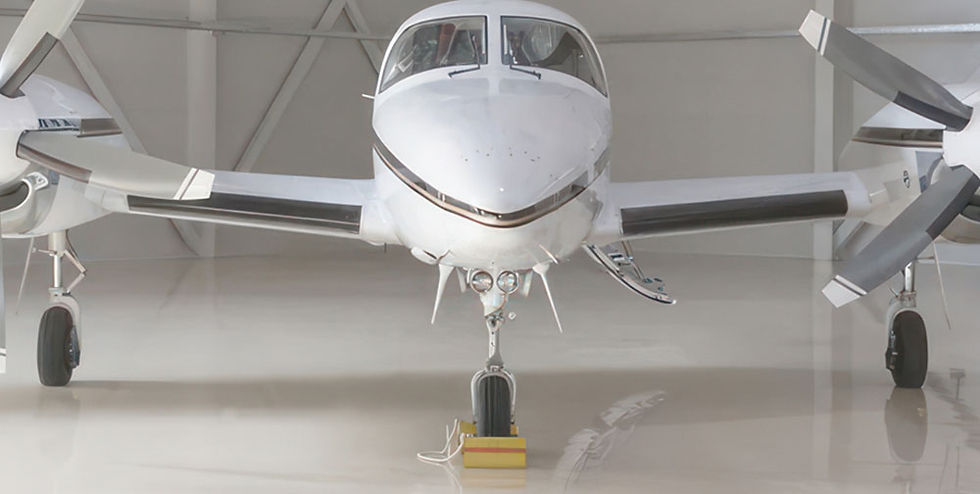Maintaining a pristine and functional concrete floor in your aircraft hangar is crucial for operational efficiency and aesthetics. If you need help with starting your resurfacing project, this guide will help provide you with the essentials to take your first steps.
Firstly, when is the right time to resurface your hangar floors? Here are some signs it’s time to give your aircraft hangar floor a revamp:
High-end client requirements: Hangar presentation impacts client perceptions in the competitive aviation industry. High-end clients expect top-notch facilities, and a well-maintained floor reflects the quality and attention to detail that they anticipate.
Appearance of common problems: Hangar floors suffer from yellowing, moisture intrusion, and peeling over time. High gloss and reflectivity are essential for safety and aesthetics.
Fuel and chemical spills: Hangar floors must withstand exposure to jet fuel and other harsh chemicals, ensuring longevity and safety.
Consequences of Not Resurfacing Concrete Floors in Aircraft Hangars
Resurfacing hangar concrete floors can feel daunting, and you might be tempted to keep delaying the project until the issue is too far gone. Here’s what could happen if you don’t regularly resurface your concrete floors:
· First up is aesthetics. A neglected floor is unsightly, affecting your hangar’s overall appeal, and potentially impacting business.
· Then come structural issues. Unaddressed cracks can expand, leading to concrete delamination and an unstable surface. Spalling and pitting further degrade the floor, creating an uneven and hazardous environment.
· Finally, you face operational challenges. Tug motors, which rely on flat surfaces, struggle on damaged floors. Debris from unclean and degraded floors impedes operations and poses risks to aircraft and personnel.
Questions to Answer Before Resurfacing Hangar Concrete Floors
What type of flooring is best for your hangar? Consider your hangar’s specific needs. Epoxy, polyurethane, and other high-performance coatings each offer unique benefits. Your choice should align with your operational demands and client expectations.
What type of gloss do you need? The level of gloss impacts both aesthetics and functionality. High gloss enhances reflectivity, improving visibility and safety, but it also requires more maintenance to keep it clean.
Before starting your resurfacing job, you should have a clear end-goal in mind. Here’s what you need to look for to ensure an excellent resurfacing job:

Gloss and uniform color: A consistent, high-gloss finish enhances the hangar’s visual appeal and ensures optimal light reflection. Uniform color across the floor contributes to a professional look.
Texture and slip resistance: Incorporating aluminum oxide or other slip-resistant materials into the topcoat ensures safety without compromising appearance.
Flawless finish: Aim for a flawless, uniform surface without visible cracks or joints. This finish improves the floor’s aesthetics and enhances its durability and functionality.
Chemical resistance: Your resurfaced floor must be resistant to aviation fuel, hydraulic fluid and other chemicals.
Additional desirable features include custom logos or markings, enhanced UV resistance to prevent yellowing, and easy maintenance coatings that reduce cleaning efforts.
What Options Do You Have for Achieving these Results?
Now that you know what results to aim for, it’s time to understand what you need to get there.

Thin-mill, resinous floors provide a sleek, high-gloss finish, ideal for light traffic areas. Liquid-applied floors offer seamless, durable surfaces resistant to chemicals and wear.

2. Re-surfacers and epoxy layers can repair minor damage and create a smooth, uniform base.
3. Mortar systems are suitable for addressing significant damage or heavy traffic areas.
Top Errors to Avoid
Resurfacing hangar concrete floors is a complicated task. You’re bound to encounter hurdles on the way, but here are some you must try to avoid at all costs:

Neglecting moisture mitigation: Failing to address moisture in your floor typically leads to coating failure. Implement a moisture mitigation system to prevent issues.
Ignoring topcoat texture: Ensure the topcoat has adequate texture to prevent slips and falls, especially in wet conditions, is vital.
Choosing too light a color: While white floors may look clean initially, they show dirt and wear quickly. Light gray offers a balance between aesthetic appeal and ease of maintenance.
Sealing concrete alone: Sealing concrete without adding chemical-resistant coatings can result in damage from spills and chemicals. Ensure your floor coating system is robust enough to handle aviation fuel and other substances.
A Step-By-Step Guide for Resurfacing Hangar Concrete Floors
Now, it’s time to put all your learnings together. Here’s a step-by-step guide to help you start and oversee your hangar floor resurfacing project:
Step 1: Research coatings: Investigate multiple types of floor coatings to determine the best fit for your hangar.
Step 2: Get a second opinion: Consult with industry experts or other hangar managers to gather insights and recommendations.
Step 3: Use authorized installers: Ensure your installer is authorized by the coating manufacturer to guarantee quality and warranty. Choose a contractor with experience in aircraft hangar flooring, positive reviews, and certifications from major coating manufacturers. Ensure they offer a comprehensive warranty and follow industry best practices.
Step 4: Clear the hangar: Move all equipment and aircraft out of the hangar to allow unobstructed work.
Step 5: Prepare for dust and debris: Resurfacing generates dust and debris. Protect surrounding areas and equipment.
Step 6: Climatize the area: To ensure proper curing, maintain an ideal temperature of 60 to 80 degrees Fahrenheit and avoid high humidity during application.
Contact Rio Flooring Systems Today
Resurfacing hangar concrete floors doesn’t have to be a daunting and annoying job. With the right people and right products, you’ll enjoy high-quality concrete floor resurfacing hassle-free. Contact Rio Flooring Systems for expert advice and professional resurfacing products. Our team delivers high-quality, durable flooring solutions tailored to your needs. Let's talk.


